The Ultimate Belize Travel Guide
There are half a dozen things in the jungle that worry me: skinny green vine snakes, 200-pound panthers, all kinds of poisonous plants. And yet I’m walking through the dense jungle in a bathing suit, with an inflatable tube hanging from my shoulder as if I’ve not a care in the world. Therein lies the beauty of Belize—the country is an odd mixture of foreign and familiar, a living contradiction in the most fascinating ways. It sits in the middle of Central America, flanked by Mexico and Guatemala, but has more in common with Caribbean culture than its immediate neighbors. The country welcomes foreigners as an integral part of its economy (and takes the American dollar), yet it has managed to resist some of the biggest trappings of that international influence. For example, there are no American chain restaurants. Kentucky Fried Chicken tried to open some locations here in the eighties, but it didn’t stick; locals were curious but ultimately more satisfied with the mom-and-pop shops that operate in backyard kitchens and the women who sell snacks out of coolers on the side of the road.
I’m not suggesting Belize has some sort of identity crisis. On the contrary, the country and its citizens seem to be very comfortable with the cultural nuances at play. It is one of the most stable nations in the region, and one of the most diverse in terms of both culture and adventure. Less than 9,000 square miles, and just 180 miles long and 68 miles wide, it’s roughly the size of Massachusetts, so you might not think there would be much to it. But get this: roughly 40 percent is protected as a park or preserve. And with only 420,000 residents, even though the country’s landmass is small, it’s not hard to find solitude.
Mayans are the original denizens of Belize, having called it home since 1500 B.C., with communities inhabiting the Maya Mountains. Creoles, the descendants of enslaved Africans, make up roughly 24 percent of today’s population, while the majority of Belizeans are Spanish-speaking mestizo, a mixture of Maya and Spanish. The Garifuna, descendants of shipwrecked Africans who blended with native islanders, comprise a small but culturally significant portion of the demographic as well. More recently, a large influx of German-speaking Mennonites and Chinese immigrants have helped diversify the pot. Because the country was a British colony until 1980, English remains the official language (and Queen Elizabeth is still on all of the local currency), but due to the cultural diversity, most Belizeans speak three languages. They grow up speaking Kriol, are taught English in school, and many learn Spanish, thanks to the influence of their Central American neighbors.
The landscape is just as fascinating as the culture. With 240 miles of coastline along the Caribbean Sea, forest-covered mountains in the west, and peaks that rise up to 3,600 feet, Belize shifts between broad-leaved jungle, arid pine hillsides, and a coastline peppered with more than 450 cayes (small, low islands) that are strung together over the world’s second-largest barrier reef. You’ll find restored Maya ruins on one side of the country and seaside villages on the other.
Despite all this, most Americans know little about the country. We’ve made our mark and explored every inch of Costa Rica and Mexico, but aside from a handful of expat retirement communities and a few beach towns that get hammered with tourists, Belize is still largely a mystery.
What many have heard of is the Great Blue Hole, a sinkhole amid the barrier reef that Jacques Cousteau labeled one of the best diving spots in the world. The site, with a diameter of 1,000 feet and a depth of 400 feet, is truly amazing, but even more so is the thriving reef that surrounds it, an equally popular attraction.
I recently spent seven days trying to crack the mystery that is Belize. I followed Maya guides into caves and over towering ruins. I snorkeled with third-generation professional watermen and hiked through jungles looking for monkeys and wild cats. I ate a steady diet of stewed chicken with rice and beans in the mountains and seafood prepared every way possible on the coast. I couldn’t get enough of local delicacies, like banana jam and Marie Sharp’s pepper sauce, both of which changed my life in small yet not insignificant ways. I fully admit that a week was not enough. Even though I was constantly moving, always seeking the next adventure, I barely scratched the surface. Belize remains a mystery. A delightful mystery. And I can’t wait to go back.
What You Need to Know Before You Visit
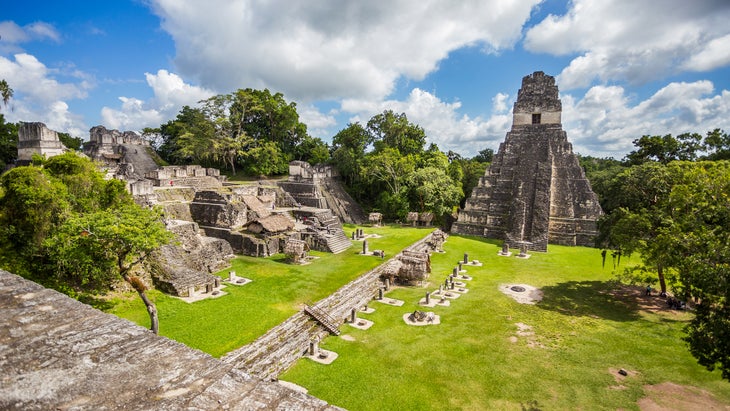
Hire a guide. I enjoy the discovery that trekking alone in the wilderness provides, but you should consider hiring guides for most of your pursuits in Belize. First, adventure guiding is a growing business here. Second, every guide that accompanied me grew up in the country and has a passion for their backyard and its resources. But mostly, you won’t know what you’re looking at without a guide. For instance, I toured Caracol, an impressive site of Maya ruins, with a guide and learned about how the city supported evidence of a middle class in the civilization and also that they believed the saba tree could span heaven, earth, and the underworld. In fact, some Maya sites, like the ATM cave (see below) require accompaniment by local guides to help preserve the sanctity of the area.
Getting around is slow going. It’s a small country, but it takes a long time to drive from one side to the other because there are only four paved highways. Belize is divided into six different districts, though most travelers stick to the mountains in the west, the coastal towns to the south, and the cayes that punctuate the sea. Aside from the highways, the rest of the roads are dirt, which require a four-wheel drive and can become impassable after a hard rain. Land travel between districts and towns is so tough that many travelers and locals take puddle jumpers between the bustling towns of Belize City, San Ignacio, Placencia, and the cayes. Keep this in mind if you’re planning to drive over to the next town or park—20 miles could take an hour or two.
Prepare for the jungle. If you’re going to spend time in the interior, you’ll be in a subtropical ecosystem that has all the hallmarks of a jungle: heat, humidity, and bugs. Lightweight hiking pants and long-sleeved sun shirts will be your best friends when it comes to keeping the bugs off. A layer of deet helps, too. That said, during my time in Belize, I didn’t find the mosquitos to be any worse than what I’ve experienced in Florida or South Carolina. Take a few precautions and you’ll be just fine.
Be serious about conservation. In 2017, the country passed a moratorium on oil exploration in Belizean waters, making it one of the few countries in the world to do so. In the past few years, the government has reigned in illegal fishing while expanding its offshore conservation areas, where hundreds of islands are dotted with resorts catering to anglers, paddlers, and divers. The most tangible and dramatic restoration effort happened recently, when the country sank the Winconcrete, a former World War II ship that will serve as an artificial reef, enhancing both the local ecosystem and its tourism draw. And last year an environmental coalition that includes the Nature Conservancy, Rainforest Trust and the World Land Trust purchased 236,000 acres of the Belize Maya Forest, protecting roughly 9 percent of the country’s landmass in a single effort.
Understand that it’s a rapidly developing country. After Belize broke from colonial rule, it experienced a huge developmental leap within a single generation. The growing pains are still apparent (a young road system is the most obvious), and much of the country’s residents remain below poverty level, but the future of Belize looks bright, particularly in terms of eco-tourism and conservation. Before the pandemic, lodges, parks, and Maya sites in the rainforest gave the local economy an annual boost of $15 million. Overall, ecotourism is responsible for $1 billion in annual revenue and more than 20,000 jobs in Belize.
Embrace soft adventure. The mountains and jungles are ripe for serious adventure, and dedicated residents are hard at work developing mountain-bike trail systems and rock-climbing routes. The potential for canyoneering in the Maya Mountains is off the charts as well. But by and large, guided adventures are of the soft variety, and most companies and resorts will steer you toward zip-line tours and cave-tubing opportunities. But don’t fret; the guides are locals who know the jungles well and are often willing to customize an adventure for a client. If there’s a river you want to explore, or a multiday excursion you’re dying to experience, ask your guide what’s possible. They’ll probably accommodate you.
Consult travel advisories. While certain sections of Belize City are widely regarded as dangerous due to gang activity, I stuck to touristy neighborhoods and felt safe there and throughout my travels. As always, it’s important to exercise caution and avoid making yourself a target for pickpockets. Check the current travel advisory status from the U.S. Embassy so you can make an informed decision.
Do a lot of research if you want to camp. The country has a variety of established campgrounds, both in the jungle and along the cayes. Most jungle preserves and parks offer camping options, and you might have the entire area to yourself, as the activity isn’t as popular in Belize as it is in the U.S. You’ll need to research each park you’re visiting directly to make sure they have sites for rent, as there’s no central reservation database. Be sure to bring everything you need; you won’t find any independent outdoor stores here.
The Best Time of Year to Visit Belize
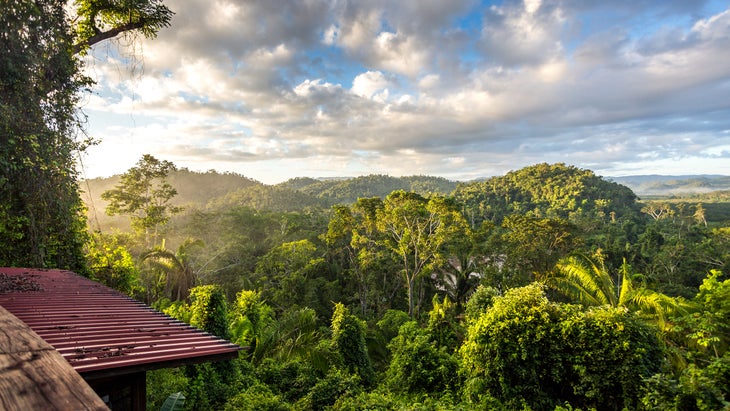
Those who visit in the high season, which runs from late November to mid-April, will enjoy consistently pleasant weather, with little rain and mild but warm temperatures that peak in the mid-eighties. It can get chilly at night and in the morning, though, especially in the mountains.
The rainy season coincides with hurricane season, running from June through November, though days typically only see brief afternoon thunderstorms. Hurricanes peak in September and October. The amount of rainfall differs depending on the region, with the south getting three times as much (150 inches) as the north (50 inches).
Aside from April and May, which are the hottest months, when the mercury might might hit triple digits, the temperatures are relatively consistent in Belize. Winter weather is definitely warm enough for swimming in the ocean, although occasional cold fronts, called “northers,” will swoop in for a few days at a time.
Crowds disperse during summer months, and you can find the lowest prices then, but you’ll also deal with the most finicky weather.
How to Get There and Around
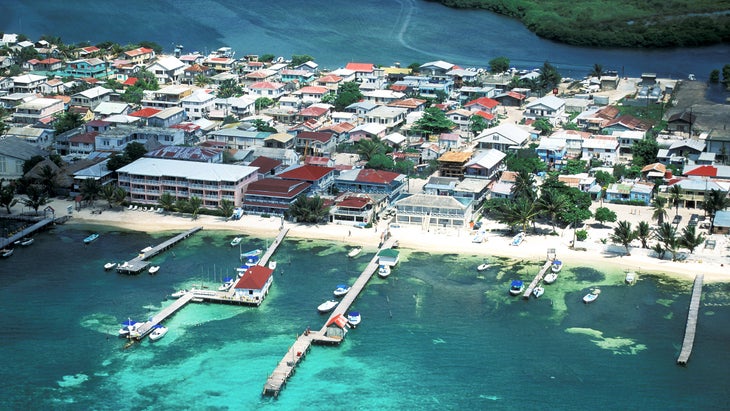
Getting to Belize
There are an increasing number of direct flights, most of which fly into Belize City, at the center of the country. Alaska, American, Delta, and United Airlines all offer direct flights to Belize City year-round, and Frontier, Southwest, and Sun Country Airlines are now offering direct flights during peak season.
Getting Around Belize
Renting a car is straightforward, and a number of major companies have offices in the Belize City airport, but keep in mind all car rentals have to be returned to their point of origin, and gas is three times as expensive in Belize as it is in the U.S. If you’re going to explore the jungle, it might make sense to rent a four-wheel drive.
While there’s an expansive bus system, it can be slow and unreliable. If you don’t want to rent a car, many resorts offer transfers from the airport. A guided hike or adventure usually includes pickup and drop-off, and many services can also be hired to transport you between cities.
If you’re spending most of your time on the cayes, skip the rental and simply book transfers to airports and ferry landings. Regional airports connect key cities on the mainland to a few of the larger cayes off the coast, and Maya Island Air and Tropic Air run daily flights between points. Ferries and water taxis will also carry you to the larger and smaller cayes.
Where to Go in Belize
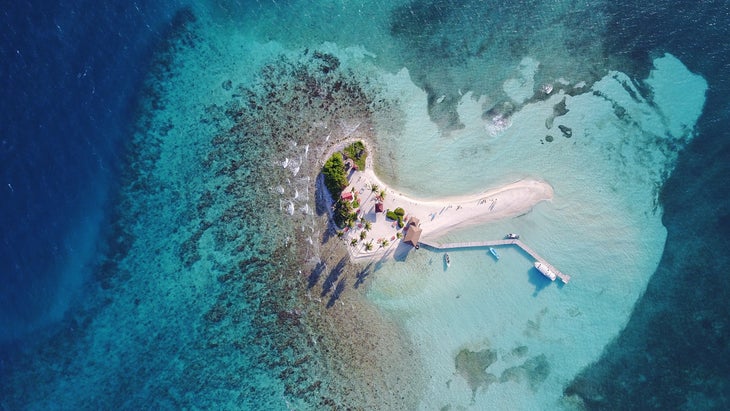
It’s a small country, so you might be inclined to try and “see it all.” Don’t. If you only have a few days, pick one region. If you’re there for a week, consider splitting your time evenly between the islands and the mountains.
There are four regions: northern Belize, western Belize, southern Belize, and the cayes. Central, coastal Belize City offers quick access to the cayes via puddle jumpers and ferries. It’s also the starting point for the only paved highways headed north, west, and south. Western Belize is mountainous, full of waterfalls, Maya archeological sites, caves, and jungle resorts. Off the coast, the 450 cayes are a mix of privately owned, bustling centers of tourism and pristine preserves.
The reef acts as a sort of glue, linking all these islands and attracting snorkelers, divers, and anglers. Southern Belize is home to coastal towns with a vibrant Garifuna culture, like the scrappy port town Dangriga, and up-and-coming tourist towns, like Hopkins Village and Placencia. Inland you’ll find wild rainforests that hide animal preserves and archaeological sites. Northern Belize is the country’s hub of agriculture. Sugarcane is the main crop, but you’ll also find groves of bananas and pineapples.
We’re focusing on the hot spots of adventure—western Belize, southern Belize, and the cayes. Follow this guide to explore Maya sites, trek through jungles and caves, and island-hop along the Mesoamerican Barrier Reef, paddling, diving, and fishing as you go.
Western Belize
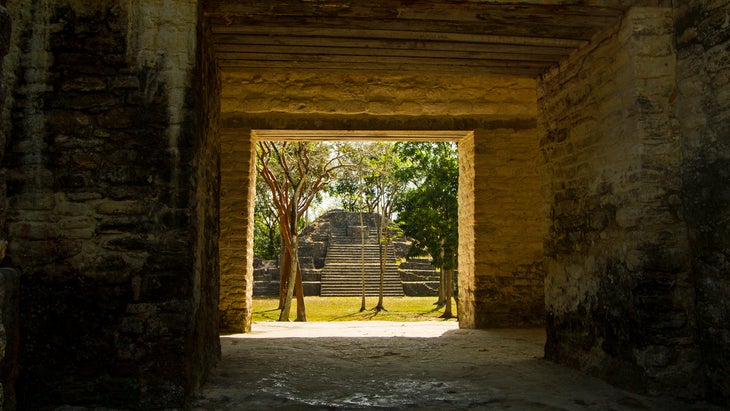
The 72-mile Western Highway runs from Belize City to the town of San Ignacio, a bustling hub with a lively food and bar scene roughly 11 miles from the Guatemalan border. As you make this drive west, the terrain quickly goes from floodplain (Belize City sits below sea level and was evacuated in the 1960s after a hurricane) to scrub brush to lush tropical forest. The mountains in western Belize rise to 3,681 feet, serving as a backdrop to communities like San Ignacio and Belmopan. From San Ignacio, the pavement mostly ends and the mountain roads that define western Belize can only be tackled by a four-wheel drive.
The terrain is decidedly jungly, with lush broad-leaved forest dominating most of the slopes and limestone crags giving way to hundreds of caves. Rivers run wild, offering numerous waterfalls and swimming holes. Citrus trees are everywhere, and Belizeans like to pull the fruit from the tree before it’s ripe, slice it, and eat it with salt, pepper, lime, and Marie Sharp’s pepper sauce. Mountain biking and rock climbing are gaining popularity, and more routes are being built every year. But if you’re in the Maya Mountains, you want to spend your time trekking to waterfalls, exploring caves, and visiting Maya ruins.
Some of these adventures can be done on your own, but again, splurge for a tour guide so you can fully comprehend the magnitude of what you’re seeing. Even if you’re not camping and you’re only exploring for a day, bring everything you need with you—snacks, extra layers, extra water. And try not to be the last car out of the parking lot; the roads in the mountains are remote and rough, so if you break down, you want there to be one more car coming behind you to help. Otherwise you’ll be spending the night.
What to Do
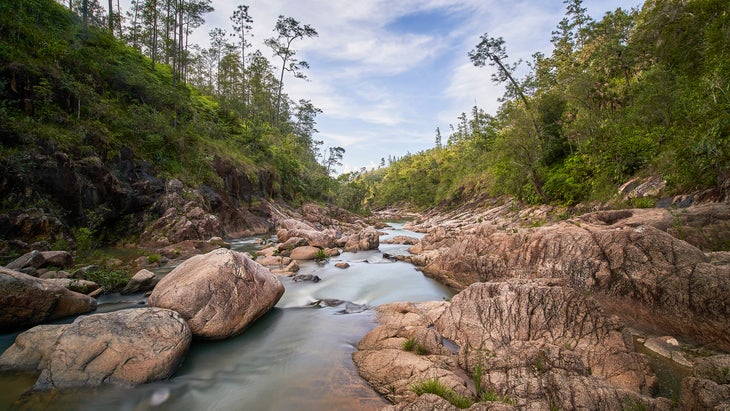
Explore Caracol
Caracol is a massive Maya city that’s now protected by Chiquibul National Park, the country’s largest, with multiple structures ranging from the foundational walls of “suburban” neighborhoods to towering temples. The ruins are not as famous as Tikal, in Guatemala, but it rivals its cousin in size and historical significance. In fact, the two cities would often battle each other, and toward the end of the Classic Period (250 to 900 A.D.), Caracol conquered Tikal and was the capital of the civilization in the region. The Maya flourished during this time, domesticating corn and erecting buildings with stone walls. Caracol supported up to 150,000 people, which is bigger than modern-day Belize City. The central structure of Cana, which translates to “sky place,” is still the tallest manmade structure in the country.
Hiking through the site doesn’t require putting in many miles, but access to the structures is essentially unchecked—nothing is technically off-limits. While you can climb the massive stone steps and learn about the Maya in a hands-on way, be sure to tread lightly. Kungo Belize offers guided walking tours of the site that delve into its significance; a hot lunch of stewed chicken, rice, and beans is included (from $60 per person).
Hike and Swim the Mountain Pine Ridge Forest Reserve
This reserve protects a rare pine forest atop 2,000-foot-tall mountains, but the real gem here are the rivers, which have carved tight gorges through granite and massive caves through limestone. Rio On Pools is the easiest waterfall to get to, about 20 miles from San Ignacio, and it’s worth a quick stop, but don’t spend too much time here, as it’s probably the least impressive feature in the area. Take the short but steep hike to Big Rock Falls, a 150-foot vertical drop surrounded by boulders to jump from. If you’re feeling brave, swim and climb your way a mile downriver, exploring chutes and cascades en route to Five Sister Falls, located below Gaia Riverlodge, where you can order a cocktail, or take the resort’s nature trail to the secluded pool at the base of the 20-foot twin Little Vaquero Falls.
Cave into Maya Culture
There are more than 400 known cave sites in Belize, 80 percent of which contain Maya artifacts. The most spectacular of them all has to be the Actun Tunichil Muknal (ATM), which requires a semi-technical descent more than a mile underground. It’s like canyoneering into the center of the earth. After a river crossing and a hike through the rainforest, you’ll swim into the mouth of the cave, then wade through channels, squeeze through narrow hallways, climb rock slabs, and spot the remnants of pottery and human remains dating from 300 to 900 A.D., all of which were used as sacrifices to the gods.
As you travel deeper, you can see how the Maya became more desperate as they lived through a two-century-long drought, moving from a culture that gave thanks to the gods with food and pottery to a culture that pleaded with the gods with human sacrifices. Only guided parties can enter the ATM cave, and local guides receive special certification to ensure the cultural heritage of the site is honored. Book your guide in advance, as there are no guides on-site available for tours (from $100 per person).
Where to Stay
Gaia Riverlodge
This 16-cabana resort will put you in the heart of the mountains in a high-end thatch-roofed hut overlooking Provincial Creek and the Five Sisters Waterfall. Even better, on-site hiking trails lead to multiple other falls. If you’re lucky, Coco, the resort dog who has her own thatch-roofed hut, will follow you on adventures throughout the property. The food is top-notch, too. Ask for the banana jam with your breakfast; it changed my life. From $205
Midas
If you want to stay in the middle of San Ignacio and have multiple restaurants and bars within walking distance, this hotel has 40 well-appointed rooms and colorful cabanas surrounding a large pool. It also sits on 30 acres, with hiking and equestrian trails. From $105
San Miguel Campground
This drive-in campground is located in the Mountain Pine Ridge Forest, above Big Rock Falls and close to Privassion Creek. Make sure you bring everything with you, as it’s miles from the nearest town and there are no stores or visitor centers to stock up on provisions. Camping in Belize is all about self-sufficiency. From $30 per person
The Best Place to Eat and Drink
San Ignacio is busy and charming without feeling like a tourist destination. On Burns Avenue, a collection of bars and restaurants are popular with locals, Guatemalans that come across the border, and adventurous tourists. Ko-ox Han-Nah is a good place to look for traditional Belizean food (rice, beans, and stewed chicken or pork) but it also serves solid vegetarian options, like mixed veggie curry.
Southern Belize
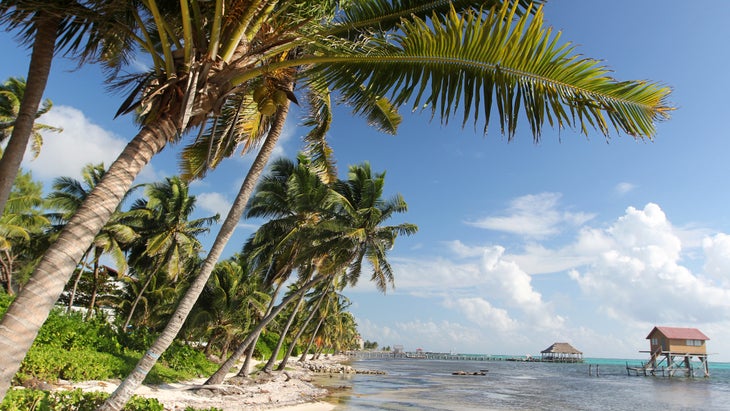
This region is a tangle of lively coastal towns and beach bars, thriving wildlife preserves, pristine beaches, lesser traveled Maya sites, and active Garifuna culture. For the most part, it’s not as busy as western Belize and there are still vast tracts of jungle and forest that tourists and even most locals visit, particularly in the southernmost tip of the country.
What to Do
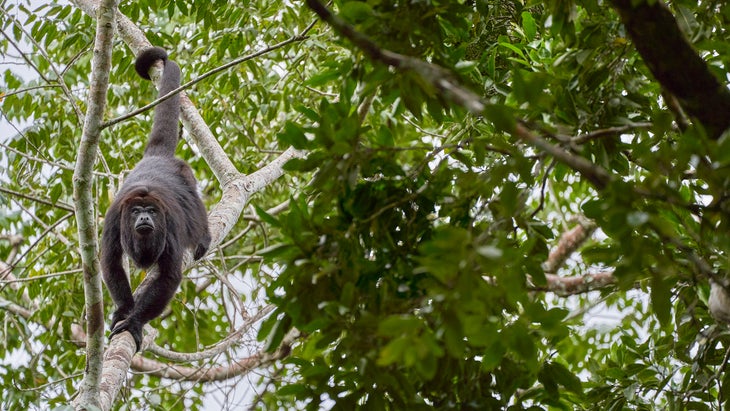
Explore Hummingbird Highway
The Hummingbird Highway, running 55 miles between the capital of Belmopan and coastal town of Dangriga, is hands down the prettiest road in the country. It’s flanked by the occasional orange grove and small village, which give way to steep slopes on either side of the road covered with palm-leaf forests. Most people drive the highway, but its length, hilly nature, and scenery beg to be cycled. You can rent basic-level bikes in the towns of Hopkins and Placencia (think: cruisers and older mountain bikes), but don’t expect top-end equipment. If you want to pedal Hummingbird Highway (or anywhere in Belize), it’s best to bring your own rig with you.
Whether you’re driving or cycling, make a pit stop at Billy Barquedier National Park, a 1,600-acre tropical forest at milepost 17 where you can take a 20-minute hike to a waterfall with a swimming hole that’s tucked inside a limestone gorge plastered with moss, ferns, and palms. Après at Mrs. Bertha’s Tamales, a red and white roadside stand that has what might be the best tamale in the nation. Get there early before its spicy chicken tamale sells out.
Look for Jaguars
The Cockscomb Basin Wildlife Sanctuary and Jaguar Preserve is the only one of its kind in the world, a 128,000-acre oasis of mountains and rivers set aside specifically for the protection of the big cat. Much like the rest of North and Central America, hunters have done a number on the species in Belize. As other countries made hunting them illegal throughout the 20th century, wealthy hunters could still travel here and pay up to $25,000 for the shot. Needless to say, populations were dwindling when the preserve was officially recognized in 1986. Today more than 100 live within the preserve, many of which grow to 200 pounds, thanks to a steady diet of armadillos. Sightings of the jaguars here are still rare, however (the animal is notoriously elusive), so you don’t need a guide. Trails are well marked and extend from a staffed visitor center into the low-lying rainforest surrounding the wide, meandering South Stann Creek. This rich biodiversity is as much the draw as the chance of spotting a big cat.
Sign up for a trip with D’Tourz, and you’ll get the lowdown on local flora and fauna from a guide who makes a habit of poking sticks into holes until something cool crawls out (it’s usually tarantulas the size of your hand). The operator also runs mini-canyoneering adventures that will have you jumping off of waterfalls through a tight, limestone gorge, followed by a mellow float by tube along the South Stann Creek River. Even better, hike the preserve at night, from 6 P.M. to midnight, and you’ll get to see the forest come alive with snakes, spiders, and (fingers crossed) jaguars.
Boat the Monkey River
The howler monkey is a cartoonish creature, big and loud, and can be found hiding in the jungle canopy. Your best bet for seeing these primates is by taking a boat up the Monkey River, an hour and a half south of Placencia, off of the Southern Highway. The journey starts at the mouth of the river as it dumps into the Caribbean at the small hub of Monkey River Village.
Head with a guide (from $120 a person) on a small powerboat into mangrove forests filled with manatees, crocodiles, giant iguanas, and toucans. Deeper in the jungle, a short hike will bring you to an area where howler monkeys thrive. They live in tribes and are prone to howling at each other when one tribe encroaches on the territory of another, but they’re not aggressive, even though their call sounds like the scream of a dinosaur. The worst thing they’ll do to you is pee or poop on you. Seriously, don’t let them pee or poop on you.
Where to Stay
Belizean Nirvana
This two-story hotel has rooms on the water, each with its own share of Caribbean-facing beachfront. It’s located in Placencia, a funky village at the end of a peninsula with luxury resorts, expat retirement communities, and restaurants and bars where you’re likely to see as many locals as tourists. Get a first-floor room and you’ll have a porch that spreads out into the sand. The beach is stunning, a narrow strip of sand dotted with coconut trees, with a mellow bay on one side and small resorts and lively bars and restaurants on the other. The heart of the village is a pedestrian-only street lined with beachfront dining and drinking establishments. From $190
Detours
You’ll find Garifuna culture throughout the coastal towns of southern Belize, but Dangriga is the epicenter, home to regular festivals, museums, and drum-making shops. Check out the Gulisi Garifuna Museum to learn about the history of the people and their contributions to today’s vibrant cultural community, and step into the Lebeha Drumming Center to try your hand at working the instruments, made from mahogany and deerskin.
If you’re looking for seafood and elevated cocktails, Muna, a rooftop restaurant at the top of a boutique hotel in Placencia has the best of both. Order the Seafood Sere, a Garifuna chowder served with coconut rice and plantain chips.
The Cayes
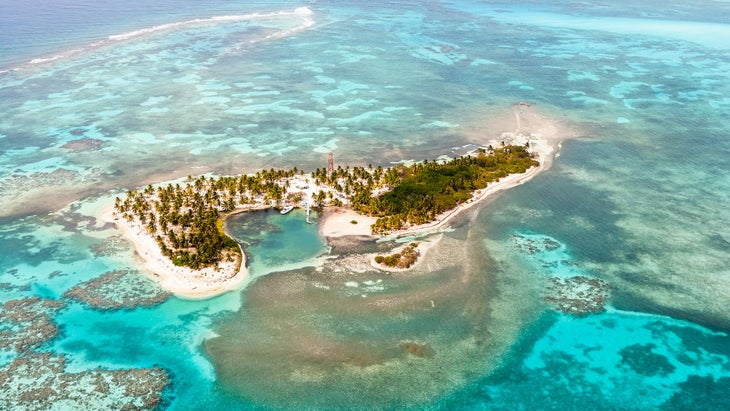
Belize is absolutely lousy with islands. These act as exclamation points along the Mesoamerican Barrier Reef, the second-largest reef system in the world and one of the healthiest of its size. Yes, the Great Blue Hole is here—a seemingly bottomless pit that you can dive into, paddle around, or fly over during a scenic tour—but there is so much more to this area than diving into a hole.
Sandy beaches are rare here, but they do exist if you know where to look. The ironically named “Secret Beach” on Ambergris Caye is the most popular, boasting restaurants and thatch-roofed picnic tables jutting out of the water. There’s world-class snorkeling and diving everywhere, some of the most productive saltwater fly-fishing in the world, and paddling options that range from easy two-hour spins to multiday bucket-list adventures.
Local airlines Maya Air and Tropic Air operate regular puddle jumpers making trips from the mainland to Ambergris Caye and Caye Caulker, the two busiest cayes off the coast. There are also regular ferries that connect the major islands, and you can hire boats and guides to take you to smaller, more remote islands along the reef.
What to Do
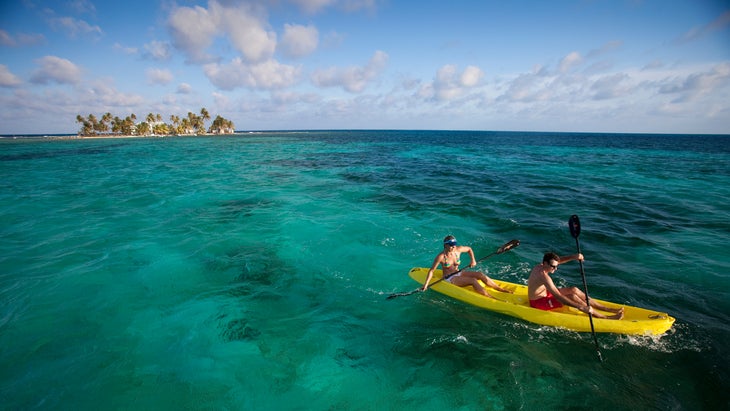
Swim with Sharks
OK, they’re nurse sharks, and they’re more harmless than the fish that follow them around feeding on their scraps, but they’re still sharks. And they can get quite big (a nine-footer swam beneath my feet while I was in the water). The sharks like to hang out in a break in the reef system dubbed Shark Ray Alley in the Hol Chan Marine Reserve. Book a snorkeling trip to the reef (from $55 per person for a half day), which includes a stop at Shark Ray Alley. Sure, the snorkeling is amazing and you’ll get to see all kinds of species, but come on… sharks. That’s the story you’ll tell when you get back home, not the parrotfish you saw.
Paddle the Islands
The breadth of the barrier reef and the sheer volume of islands that stretch across it make Belize an open-water paddler’s dream. A variety of experiences exist here, from casual half-day excursions within eyesight of high-end resorts to multiday adventures that will have you camping on primitive islands.
Caye Caulker, a 10-minute flight or 45-minute ferry from Belize City, is a great spot for beginners. The island is divided into two sections by a narrow channel, with most of the development existing on the southern side, while the northern side is occupied by a dense mangrove forest. Reef Break Surf Shop rents boards and windsurfing kits (from $13 an hour) and guided tours if you don’t want to go it alone (from $140 per person).
If you’re an experienced paddler looking for a big adventure, Island Expeditions will rent you expedition-ready gear and give you maps with suggestions for routes along the southern cayes for self-guided trips (from $255 a week or $40 a day). The outfitter also offers a trip that starts with three days of guided paddling and lodging, then four days of self-guided paddling at the Glover’s Reef Atoll, a Unesco-designated World Heritage site that covers 80 square miles of reef, islands, and open water. You can spend a few days at its base camp learning key skills, then break out on your own for a few days to practice what you learned. Norm Hann Expeditions also offers fully guided seven-day paddleboard trips throughout the same terrain. Instead of camping, you’ll stay at various lodges (from $2,559).
Fish for the Big Three
You can find world-class fishing all along the coast, and most anglers show up with their fly rods in hopes of snagging a Grand Slam, which entails catching a bonefish, tarpon, and permit in a single day. There probably isn’t a bad place to fish along Belize’s portion of the Mesoamerican Reef, but the country’s atolls have become hot spots. Turneffe Atoll, the largest of the ringed reefs, casts a halo that’s 30 miles long and 10 miles wide.
More than 150 islands along the reef serve as launching points for the lagoon, which encompasses a shocking variety of ecosystems, from expansive mangrove and seagrass habitat to saltwater flats and creeks to vibrant reef structures. Turneffe is just 20 miles off the coast, south of Caye Caulker and Ambergris Caye, so the fish do receive some pressure. If you’d prefer an area that receives less attention, head farther south to the expansive South Water Caye Marine Reserve, the largest of Belize’s eight protected marine reserves, much of which consists of shallow saltwater flats. Local anglers have dubbed the South Water Caye “permit alley,” due to an abundance of the highly sought-after species.
The Big Three are all catch-and-release only. You’ll be able to land bonefish year-round, so timing isn’t as important for that species, but permit are hungriest in spring and summer and tarpon pass through in summer. In addition to the Big Three, you’ll have the chance to cast for jack, snapper, and triggerfish. Hire a local guide service like Blue Horizon, one of the most storied in Belize (and the only Orvis-endorsed outfitter in the country), to increase your chances of success. Half-day and full-day trips depart from Hopkins or Placencia (from $350).
Where to Stay
Victoria House
If you’re looking to treat yourself, book one of the thatch-roofed villas at Victoria House, some which have their own private pool and all of which overlook a sandy beach with tall palms. The location on Ambergris Caye is ideal if you’re looking to explore the Hol Chan Marine Preserve, and in-house guides can take you on a variety of adventures. The restaurant is top-notch as well, especially its rotating selection of ceviche (get the tuna with watermelon if it’s on the menu). From $210
Glover’s Atoll Resort
This adventure resort sits on Northeast Caye, a big, sandy island on the edge of the Glover’s Reef Atoll. Its variety of inexpensive accommodations range from hostel-style bunks and individual huts built on stilts to campsites beneath coconut palms. You can cook your own meals or eat in the restaurant (lobster dinners are $22). Accommodations are basic yet charming, but you’re here for the location—snorkeling, fishing, and paddling starts right on the edge of the island. Camping from $10, cabins from $40
Thatch Caye Resort
Occupying the shorefront of a private island 30 minutes off the coast of Dangriga, this resort hosts just 30 guests at a time. Stays include meals, all beverages, and adventure gear. Choose from an oceanfront cabana or an over-the-water bungalow. From $500 a night for two guests
Where to Eat and Drink
Yeah, you’re in the islands and you’re probably craving seafood, but take a break from the conch and spend one dinner at El Fogon, in the heart of Ambergris Caye’s bustling San Pedro, where everything is cooked in the traditional Belizean way over an open fire. Don’t worry, there’s actually quite a bit of fresh fish on the menu, but don’t overlook the pork stew or chicken kebabs.
How to Be a Conscious Visitor
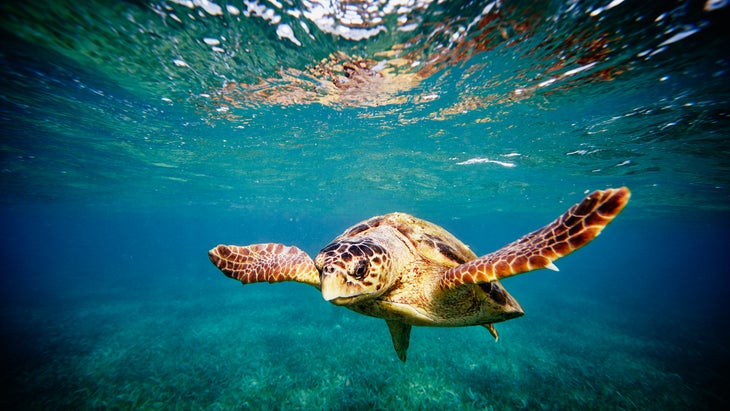
Go Local
The majority of the guides you’ll encounter here were born and raised in Belize, making it easy to pass an entire trip with local experts. The Belize Tourism Board curates a list of gold-standard guides and hotels that follow new safety and health protocols. Follow the same principles for tipping as you would at home.
Tread Lightly
The barrier reef is a living thing that’s under constant pressure from humans. Be sure to pack non-nano zinc sunscreen without extra chemicals, like Thinksport, as you’ll have a hard time finding it here. Don’t touch or stand on the reef—ever—and no matter how friendly a fish or turtle looks, don’t try to get close to them. Even hovering over a turtle is a disruption.
Eat Sustainably
It’s never been more important to know where the fish you’re eating comes from. Belize is going to great lengths to help preserve the various populations within its waters, limiting commercial operations and certain harmful practices. Check out Fish Right, Eat Right to learn what species you should seek out and which to avoid, and consult its list of restaurants that source only from local fishermen who follow sustainable practices.
